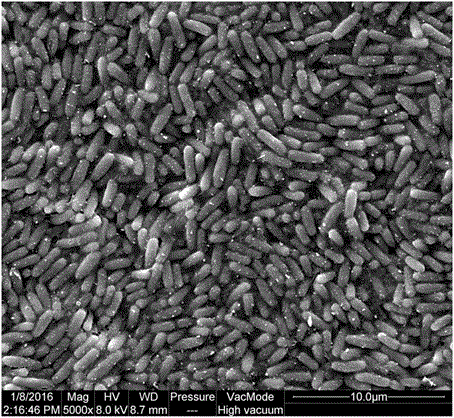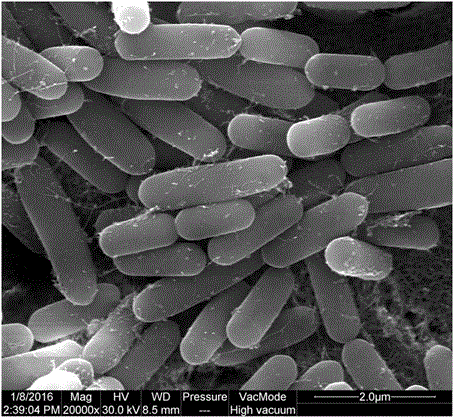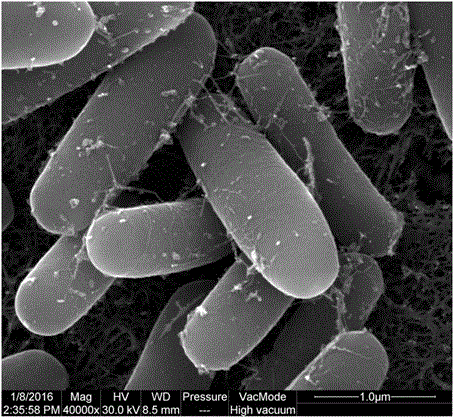Plant bacteriostasis method adopting bacillus methylotrophicus strain NKG-1
A methylotrophic and Bacillus technology, applied in botany equipment and methods, plant protection, plant growth regulators, etc., can solve problems such as endangering human health, destroying ecological balance, pesticide environmental pollution, etc., and achieve environmental pollution-free , no pesticide residue effect
- Summary
- Abstract
- Description
- Claims
- Application Information
AI Technical Summary
Problems solved by technology
Method used
Image
Examples
preparation example Construction
[0093] Preparation of the fermentation and culture filtrate of methylotrophic bacillus. The methylotrophic bacillus was inoculated into the LB medium at a ratio of 1:100, and oscillated at 37°C and 220r / min for 24h. Collect the fermentation broth, centrifuge (10000r / min, 4°C), filter and sterilize the supernatant with a 0.22 μm filter membrane to obtain a sterile fermentation broth.
[0094] Using the mycelial growth rate method to detect the effects of antagonistic Bacillus on tomato gray mold, tomato leaf mold, rice blast, pepper anthracnose, apple ring stalk, apple rot, cucumber anthracnose, wheat sheath blight, and gibberella wheat The influence of the test pathogenic fungi on the growth of the pathogenic fungus, asparagus stem rot, corn leaf spot, cotton wilt, grape black rot, tobacco brown spot, peach rhizopus soft rot, and cotton seedling blight.
[0095] Under aseptic conditions, take 10 mL of the prepared Bacillus aseptic fermentation broth and 90 mL of the melted PDA medi...
Embodiment 1
[0104] Example 1: Antibacterial method of grape black rot
[0105] Picking out the marginal hyphae cultured in opposition, microscopic observation found that the antibacterial effect of NKG-1 on grape black rot is mainly the effect on hyphae and spores. Various metabolites of NKG-1 (including antibacterial proteins, bacteriocins, antibiotics, various cell wall degrading enzymes, etc.) destroy the structure of the mycelial wall of pathogenic bacteria, causing hyphal enlargement, distortion, distortion, and disintegration of the mycelial wall. The spores constricted in the middle, the cell wall was dissolved, and the protoplasm leaked out.
[0106] The antibacterial effect of methylotrophic Bacillus NKG-1 on grape black rot is as follows Picture 10 Shown.
[0107] Table 2. The inhibitory effect of methylotrophic bacillus NKG-1 on the hyphae of grape black rot
[0108]
[0109] (1) Measurement results of the effect of the fermentation broth of methylotrophic Bacillus NKG-1 strain on th...
Embodiment 2
[0126] Example 2: Antibacterial method of asparagus stem rot
[0127] The antibacterial effect of methylotrophic Bacillus NKG-1 on asparagus stem rot bacteria is as follows Figure 17 Shown.
[0128] Table 5. The inhibitory effect of methylotrophic Bacillus NKG-1 on the hyphae of asparagus stem rot
[0129]
[0130] Effect of Methylotrophic Bacillus NKG-1 on Controlling Asparagus Stalk Rot in Greenhouse
[0131] The field experiment has 3 treatments: A. Biocontrol agent NKG-1500 times liquid; B. 25% metalaxyl wettable powder 600 times liquid; C. Blank control. 14m per cell 2 , There are 3 rows of isolation areas between the plots, and each treatment is arranged in a completely random block group, repeated 3 times, and a total of 9 plots are tested. Before the test, the plots were divided according to the test plan, and the isolation ditch was opened. The use amount of 15000mL 1×10 per hectare 7 cfu / mL biocontrol agent NKG-1. The biocontrol agent NKG-1500 times liquid is sprayed once...
PUM
| Property | Measurement | Unit |
|---|---|---|
| Bacteria | aaaaa | aaaaa |
Abstract
Description
Claims
Application Information
 Login to View More
Login to View More - R&D
- Intellectual Property
- Life Sciences
- Materials
- Tech Scout
- Unparalleled Data Quality
- Higher Quality Content
- 60% Fewer Hallucinations
Browse by: Latest US Patents, China's latest patents, Technical Efficacy Thesaurus, Application Domain, Technology Topic, Popular Technical Reports.
© 2025 PatSnap. All rights reserved.Legal|Privacy policy|Modern Slavery Act Transparency Statement|Sitemap|About US| Contact US: help@patsnap.com



